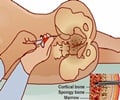The potential of the compound PRM-151 for reducing progressive bone marrow fibrosis (scarring) in patients with advanced myelofibrosis has been investigated. The study showed initial positive results.

"There was no evidence of drug-related myelosuppression or suppression of the bone marrow's ability to produce blood cells and platelets. We also saw encouraging trends in both clinical and histologic aspects of the disease," said Verstovsek. "With demonstrated reduction in bone marrow fibrosis, stable to improved hematologic parameters, symptom responses, and stable to reduced spleen size, it is clear that there is merit for further development of PRM."
Myelofibrosis is caused by the accumulation of malignant bone marrow cells that triggers an inflammatory response, scarring the bone marrow and limiting its ability to produce blood, resulting in anemia. About 3,000 new cases of myelofibrosis are diagnosed in the United States each year. Average survival ranges from two to 11 years, depending on a variety of prognostic factors.
Patients with myelofibrosis experience many debilitating symptoms including fatigue, weight loss, abdominal pain, severe itching, night sweats and bone pain. A swollen spleen is one hallmark of the disease tied to many of its symptoms.
PRM is a recombinant form of Pentraxin-2, a human protein that acts at sites of tissue damage, inducing macrophage differentiation to prevent and reverse fibrosis. PRM has demonstrated broad anti-fibrotic activity in multiple preclinical models of established fibrotic diseases and no dose-limiting toxicities in phase I trials. Verstovsek found that PRM was well tolerated both in combination with, and without ruxolitinib, another potent myelofibrosis therapy.
Source-Eurekalert









